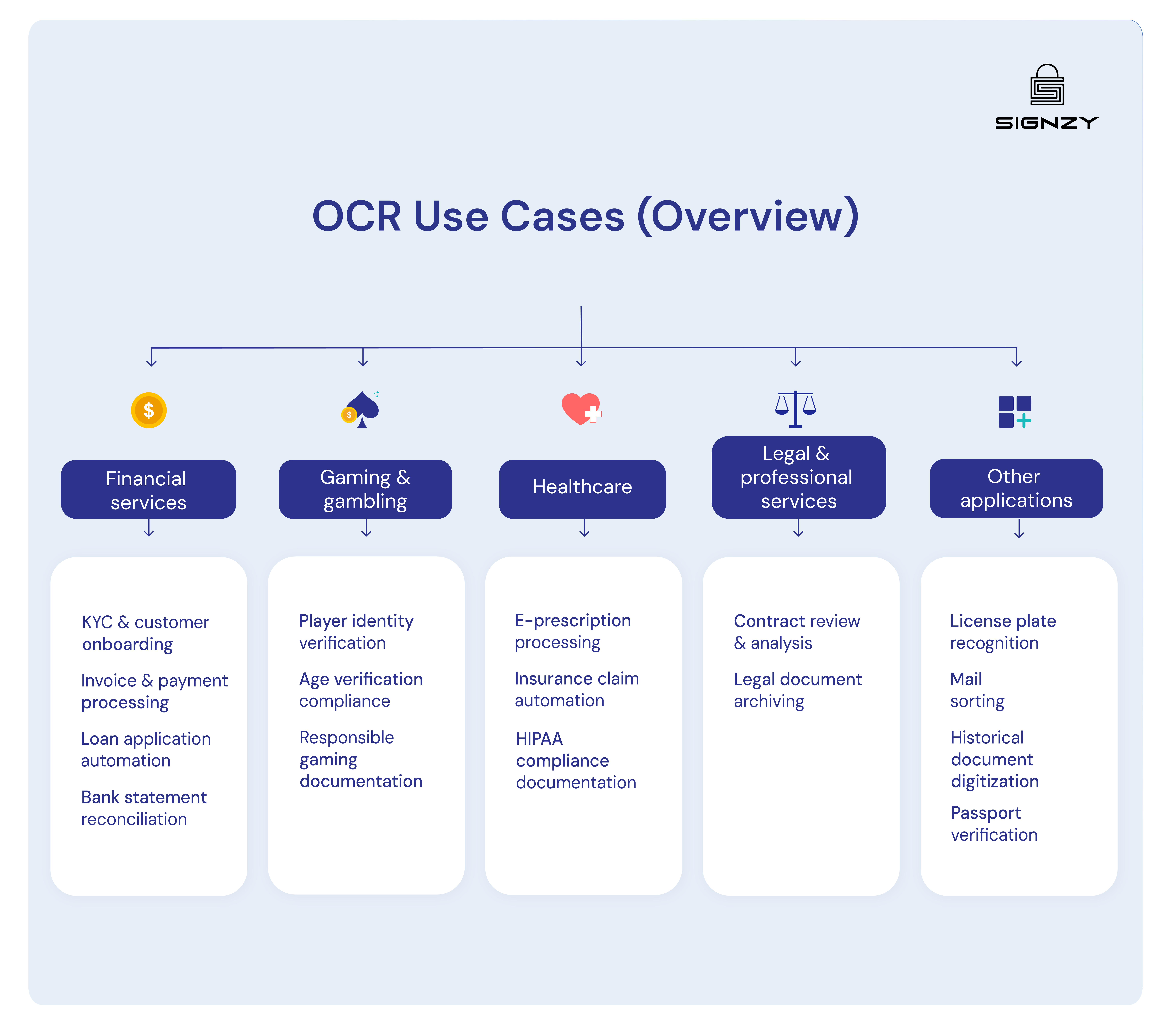OCR Use Cases Across Industries: Banking, Gaming, Healthcare & More
- OCR technology has evolved from simple text recognition to intelligent document understanding, capable of extracting context, relationships, and meaning from complex business documents.
- Cloud-based OCR solutions enable businesses to process document volumes that scale from hundreds to millions without significant infrastructure investments.
- Artificial intelligence enhancements in OCR continue expanding capabilities, with emerging features like sentiment analysis, document classification, and predictive data extraction.
Honestly, OCR used to be pretty terrible. You'd scan a document and get back something that looked like it was written by a drunk robot. But lately? It's actually useful.
I mean, think about it - we're drowning in paperwork, but everything needs to be digital. OCR is basically the bridge between those two worlds. And different industries are finding some pretty clever ways to use it.
Some are obvious, like banks scanning checks. Others are wild - like restaurants reading handwritten orders or construction companies processing permits. Let me walk you through what's actually working out there.
Related Solutions
What is OCR?
Optical Character Recognition is a technology that converts different types of documents, like scanned paper files or images, into editable and searchable data. In simple terms, it allows a computer to read text from an image just as a human would. The process goes like:
- The document is captured as a digital image.
- Software identifies characters and words within the image.
- Recognized text is converted into a machine-readable format.
The technology has been around for some time, but with recent AI improvements, it has become incredibly accurate and fast.
Now, let’s explore the use cases of OCR in some of the most regulated and document-heavy industries.

OCR Use Cases for Financial Services
The financial services industry runs on paperwork, and OCR is helping institutions speed up processes, reduce errors, and improve the customer experience.
↪ KYC and Customer Onboarding
For Know Your Customer (KYC) checks, a customer can simply take a picture of their ID. The OCR technology automatically extracts their name and date of birth to populate the application form, making the digital onboarding process much faster.
↪ Invoice and Payment Processing
Banks process millions of invoices and checks daily. OCR automates data entry by instantly extracting key information like the invoice number and amount due. This speeds up payment processing and reduces the risk of costly human error.
↪ Loan Application Automation
OCR digitizes loan applications, extracting data and feeding it into the bank's loan origination system. This helps loan officers make faster decisions and improves the borrower's experience by reducing wait times.
↪ Bank Statement Reconciliation
OCR technology simplifies importing information into accounting software and helps businesses maintain accurate financial records with less manual effort.
OCR Use Cases for the Gaming and Gambling Industry
The heavily regulated online gaming industry relies on OCR to meet strict compliance requirements for verifying player identity and age.
↪ Player Identity Verification
OCR lets these platforms quickly verify a player's identity. Players upload a picture of their government ID, and the technology extracts their information, matching it against their registration data to flag any discrepancies.
↪ Age Verification Compliance
Age Verification prevents underage gambling. By extracting the date of birth from a player's ID, the platform can instantly confirm the player is of legal gambling age, helping the company avoid heavy fines.
↪ Responsible Gaming Documentation
Many jurisdictions require gaming companies to maintain responsible gaming documents. OCR can digitize and archive these files, making it easier for companies to manage their compliance obligations and respond quickly to regulatory audits.
OCR Use Cases for the Healthcare Industry
The healthcare industry is modernizing its paper-based records with OCR, which helps digitize patient information and streamline administrative processes.
↪ E-prescription Processing
OCR can automatically scan and digitize handwritten or printed prescriptions. This avoids manual entry into a pharmacy's system, reducing the risk of dangerous data entry mistakes and ensuring patients get the right medication.
↪ Insurance Claim Automation
Processing medical insurance claims is a document-intensive process. OCR automates the extraction of data from claim forms and medical reports, speeding up the process and reducing administrative costs for providers and insurance companies.
↪ HIPAA Compliance Documentation
The Health Insurance Portability and Accountability Act (HIPAA) sets strict standards for protecting patient data. OCR helps organizations manage HIPAA compliance by digitizing and securely archiving patient records, making it easier to control access and maintain a clear audit trail.
OCR Use Cases for Legal and Professional Services
The legal profession is built on documents. From contracts to court filings, lawyers deal with a huge amount of text. OCR is an essential tool for managing this information efficiently.
↪ Contract Review and Analysis
Reviewing long, complex contracts is a time-consuming but important task for lawyers. OCR can digitize these contracts, making them fully searchable. This allows legal professionals to quickly find specific clauses, terms, or dates, which is a massive time-saver.
↪ Legal Document Archiving
Law firms need to maintain vast archives of case files. OCR allows these firms to convert their paper archives into a searchable digital database. This not only saves physical storage space but also makes it much faster to retrieve old documents when needed for a case.
Related Blogs
Other Common OCR Use Cases
While we have focused on a few key industries, OCR technology is used in a wide range of other applications:
- License Plate Recognition: Law enforcement and toll booth operators use OCR to automatically read license plates from images and videos, enabling features like stolen vehicle tracking and automated toll collection.
- Mail Sorting: Postal services use advanced OCR systems to automatically read addresses on letters and packages, allowing them to sort millions of pieces of mail every day with incredible speed and accuracy.
- Digitizing Historical Documents: Libraries and museums use OCR to digitize books, newspapers, and other historical documents, making these valuable resources searchable and accessible to a global audience.
- Passports Verification: Instead of manually typing out passport details, businesses use OCR to instantly scan them, which makes customer onboarding and identity checks much faster and more accurate.
As you can see, the applications for this technology are incredibly diverse and continue to expand.
Choosing the Right OCR Solution for Your Industry
If you are considering implementing OCR in your business, there are a few different ways to approach it:
- Build Capabilities In-house: One option is to build your own OCR solution from scratch. This gives you complete control, but it is also the most expensive and time-consuming route. You would need to hire a team of specialized developers and data scientists, and it could take months or even years to build a system that is accurate and reliable.
- Outsource It to an Agency: Another option is to outsource your document processing to a third-party agency. This can be a good short-term solution for a specific project, but it can get very expensive over time. It also means you are sending sensitive customer data to an outside company, creating significant security risks.
- Use an Out-of-the-Box OCR API: For most businesses, the most viable solution is to use a pre-built OCR API from a specialized provider. An API, or Application Programming Interface, allows you to easily integrate advanced OCR capabilities directly into your own applications.
As we can see from the three approaches above, the API route offers the best balance of speed, cost, and control. You get professional-grade technology without the development overhead or ongoing security concerns of the other options.
The challenge becomes finding a provider that understands your industry's specific requirements. Signzy has built OCR technology specifically for these regulated industries, handling everything from government IDs to complex compliance documents with the accuracy these industries require.
To know more, book a demo with us - HERE.

Agrima Dwivedi
Agrima is an Associate Product Marketer at Signzy, currently working in the B2B fintech space. She brings over two years of experience in copywriting and content writing, which laid the foundation for product marketing. Today, she leverages both creative and strategic skills to drive go-to-market efforts and build user-focused marketing strategies.


